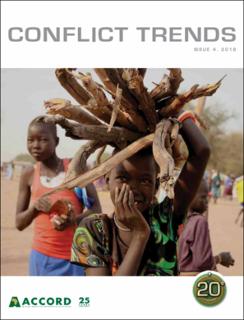The potential and limits of peace agreements: Colombia and Mali
| dc.contributor.author | Drange, Bård | |
| dc.date.accessioned | 2020-04-24T12:45:16Z | |
| dc.date.available | 2020-04-24T12:45:16Z | |
| dc.date.created | 2019-03-22T09:30:18Z | |
| dc.date.issued | 2018 | |
| dc.identifier.citation | Conflict Trends. 2018, (4), . | |
| dc.identifier.issn | 1561-9818 | |
| dc.identifier.uri | https://hdl.handle.net/11250/2652453 | |
| dc.description.abstract | Political solutions to armed conflicts are often professed by a plethora of local, regional and international actors. For various reasons, however, peace agreements often remain words on paper, not actions in the field. When can peace agreements make a difference, and help bring a country suffering from war towards a more stable and peaceful existence? This article examines the 2015 peace agreement in Mali and the case of the 2016 peace agreement in Colombia. The 2015 agreement in Mali – despite hopes to end armed violence and provide a framework for peace – has had little impact on the ground and serves to illustrate some of the limitations of peace agreements. Despite significant obstacles and setbacks, the case of Colombia, on the other hand, illustrates some of the potential of peace agreements. These cases, and potential lessons learnt from Colombia to Mali, are discussed in the context of what, with whom and when to negotiate. | |
| dc.language.iso | eng | |
| dc.relation.uri | https://www.accord.org.za/conflict-trends/the-potential-and-limits-of-peace-agreements/ | |
| dc.title | The potential and limits of peace agreements: Colombia and Mali | |
| dc.type | Peer reviewed | |
| dc.type | Journal article | |
| dc.description.version | publishedVersion | |
| dc.source.pagenumber | 15 | |
| dc.source.journal | Conflict Trends | |
| dc.source.issue | 4 | |
| dc.identifier.cristin | 1686936 | |
| cristin.unitcode | 7471,13,0,0 | |
| cristin.unitname | Fred, konflikt og utvikling | |
| cristin.ispublished | true | |
| cristin.fulltext | original | |
| cristin.qualitycode | 1 |
Tilhørende fil(er)
Denne innførselen finnes i følgende samling(er)
-
Academic books and articles collection. Open access publishing by NUPI employees. [561]
Also including chronicles, papers, research reports, etc. from other publishers than NUPI. -
Publikasjoner fra Cristin - NUPI [1426]
